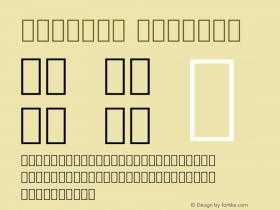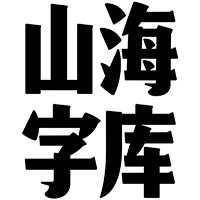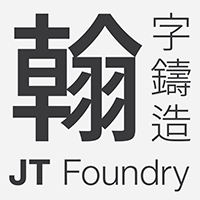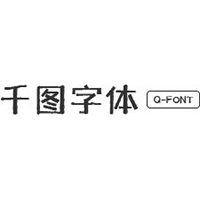Foundry Focus: Process Type Foundry

On this Fourth of July The FontFeed shines the spotlight on a (relatively) smaller American foundry that is making big waves. Located in Minneapolis, Minnesota, the Process Type Foundry is an independent type design studio specializing in the production and distribution of original contemporary typefaces. The studio is run by Eric Olson and Nicole Dotin, and is the home of the popular Klavika. Klavika has become one of the past decade's most popular typefaces. It has been a favourite of NBC and its sister stations in on-air promotions, and is in heavy use by ABC Sports/ESPN, Comcast Xfinity, General Motors, and a great number of other companies, large and small. Perhaps Klavika is most noticeable as the basis for the Facebook logo. The Process Type Foundry collection of quality type families is steadily growing. A condensed companion to Klavika, the highly legible text face Elena, the idiosyncratic sans/script Capucine and the rounded compact display face Anchor were recently added in exclusivity to FontShop.com.

When did you discover typography?
Eric Olson | "In college I suppose. I assumed incorrectly that typography was only a trade or mechanical exercise associated with the computer so I wasn't all that interested. It wasn't until I transferred to the design department from political science that I discovered typography proper. For whatever reason it was exciting to me but it wasn't until I found Emigre magazine that things changed. It seemed endless but also very close to home. I could make things myself! This was huge for me. It was soon after this that I discovered type design."
Nicole Dotin | "My story starts in college too, but in the last years of my undergraduate work studying photography. Coincidentally, this was about the time I met Eric. I was self-publishing a magazine and since I designed it myself, I started looking around at type treatments in magazines and thinking about design in general. I wanted to know how others had taken a similar problem (like designing a spread) and solved it. It wasn't until after I fully engaged with the study of typography later on, through graduate school and professional practice, that I changed my focus to type design."
How did you start out in type design?
Eric Olson | "I can't remember when I started, but it must have been around 1997. Everything was trial and error but looking back, I had a few good starting points. The climate at the time was encouraging of amateurs so it felt natural. Matthew Carter's typeface for the Walker Art Center (Walker) also debuted around this time. Living just three blocks from the museum then, it was a big deal for me. The typeface was so powerful and fitting for the Walker that it undoubtedly played a role in planting the seed of type design in me."
Nicole Dotin | "I never set out to become a type designer and even when I was working part-time for Process, it never crossed my mind that I should design a typeface of my own. Sometimes, though, ideas come to you in what can only be described as a flash of lightning. One day, the lightning hit me, and I applied and was accepted to the University of Reading's postgraduate type design program. I finished out my year of study and ended up with the beginnings of my first release Elena."
At what point did you realize type design was a viable option to make an actual living?
Eric Olson | "Type design as a career happened slowly and was never planned. I was quite happy with graphic design but always worked on type design in the evenings after work because I loved it. That was really all. I assumed I'd never be a proper type designer because though I was enamored with the classic book faces, I actually liked the simple stripped down sans serifs much more. This didn't seem like something a serious practitioner focused on so I never considered it a career option."
What made you decide to even start your own foundry?
Eric Olson | "Ironically enough, FontFont. I submitted a family of sans serifs that were wildly un-prepared for prime time and the staff rightfully rejected the submission. Later while licking my wounds and reading over the rejection letter I figured I might as well start my own foundry."
On the topic of classic book faces – you now carry one with Elena. Do you feel any self-respecting "serious" type foundry needs at least one?
Nicole Dotin | "First, we can't call Elena a classic – it's only just been released. Second, of course not. Right now, type design needs more diversity, more new ideas, more originality, more quality. It definitely doesn't need designers operating under the erroneous theory that they're only 'serious' or 'proper' type designers if they attempt certain genres. That's no way to lead a creative life by doing what you think you should do. Designers should be themselves and follow their interests, strive to meet the demands of typography, language, culture and readers, and then we can see about self-respect."
How do you decide which new typefaces to create and/or release? Is there a certain vision or a unifying aesthetic behind the collection?
Eric Olson | "Our vision for the foundry and reasons for releasing work have always been the same; we release the fonts we'd like to use ourselves. Naturally as our tastes and preferences have changed, the results have followed as well."
Nicole Dotin | "It's a very simple premise but it's worked out so far."
You have recently released your first typeface by an external designer. How did that come about?
Nicole Dotin | "In late 2010, we released Alice Savoie's Capucine, which was the first typeface from the Process Type Foundry not designed by Eric. Alice and I met at Reading while undertaking our MAs in typeface design. After the course was complete, Eric and I moved back to the States and continued as usual."
"But, somewhere along the line, we had fallen in love with Capucine. Alice had a fresh voice with something to contribute and that came though in her work. We mulled over the idea of releasing the typeface but in the end, we wanted to be a small part of helping Alice's career as a type designer. We believed not just in Capucine but also in Alice's creative potential. So, we asked her if we could distribute Capucine. She mulled that over herself since she had other offers on the table and finally accepted."
"It's possible that Capucine will be the only face not from our own hands that we release, but I can't really say. You never know when you'll fall in love."
While some foundries keep every single one of their releases available, some of your typefaces were removed from your collection. Why?
Eric Olson | "I removed my early releases Elderkin and Process Grotesque from the market because they fell outside of my future vision for the foundry. Process Grotesque was a direct revival of the Stephenson Blake Grotesques and didn't contribute anything meaningful so I didn't fret over its retirement. If I remember correctly, it was originally designed for a film festival I was doing graphic design for at the time. Elderkin on the other hand – aside from also contributing little – was just too close to another typeface from a designer I respect for me to be proud of it. Type designers, above all else, must be critical self editors and willing listeners of critique. I was neither at the time so the removal of these typefaces was part of a maturation process for me."
Does your custom type work influence your retail font releases and vice-versa?
Eric Olson | "Sometimes. Klavika Condensed is the only public release that's a direct result of a client commission. I've designed other typefaces for clients that I won't release and to that end, maybe client work influences my public work, or lack there of, more than I allow it credit for."
To conclude, let me share with you the surprising fact that the insanely popular Klavika, Process Type Foundry's most successful face to date, almost wasn't released. From my Typographica piece of December 10, 2004:
Eric Olson | "I was a little reluctant about the face for several months and even shelved it completely at one point. Anytime you apply some amount of simple geometry (in this case, straight sides) to a face the chances for stylistic overlap become great. Faces like DIN, Sophisto, Bell Gothic etc. have straight sides so the push to differentiate from them was tough. In the end I just forgot about it and tried to make an open, solid and logical typeface. Hopefully something flexible and rugged."
History tells us Eric Olson succeeded, and then some…
Header image:Eric Olson & Nicole Dotin/span>




































 闽公网安备35010202000240号
闽公网安备35010202000240号